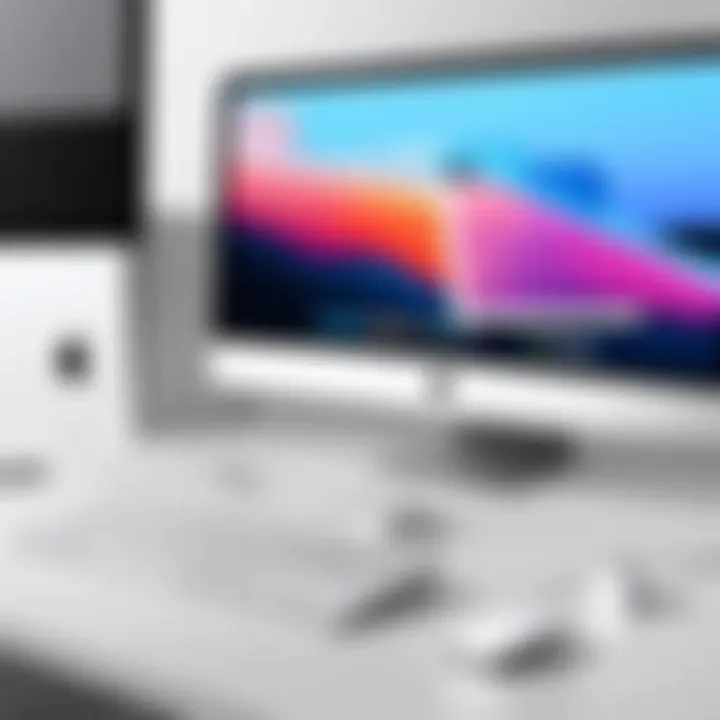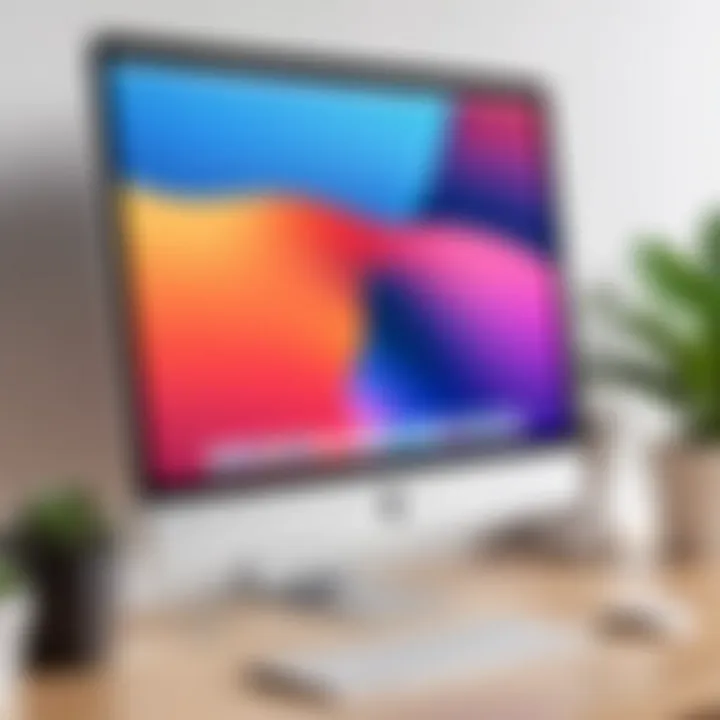Maximizing iTunes on PC: Features and Tips


Intro
In an age where digital media dominates our daily lives, managing content efficiently is essential. The iTunes app on PC serves as a pivotal tool in this regard. It assists users in organizing and accessing music, movies, podcasts, and other forms of media seamlessly.
This guide will thoroughly explore the functionalities of the iTunes app on a PC. From installation to troubleshooting, it aims to provide comprehensive insights into maximizing its potential. Understanding this application can significantly enhance one's media management experience and streamline device synchronization processes.
Overview of the Technology
Key specifications
iTunes is more than just a media player. It offers a unique ecosystem for media management. Some noteworthy specifications include:
- Media Organization: It allows users to categorize music, videos, and podcasts.
- Device Syncing: iTunes supports synchronization with various Apple devices, such as iPhones and iPads.
- iCloud Integration: The app provides cloud storage capabilities.
- User Accounts: Users can create Apple IDs to facilitate purchases and downloads.
Unique selling points
What sets iTunes apart from other media management software? The following features stand out:
- Comprehensive Library Management: It allows the creation of playlists, smart playlists, and library sharing.
- Access to Apple Music: Users can subscribe to streaming services directly through the app.
- User-Friendly Interface: The interface is designed for both novice and experienced users.
- Regular Updates: Apple continually enhances the app with new features and security improvements.
"iTunes remains a cornerstone for media management on PCs, adapting over time to user needs while maintaining a robust feature set."
Design and Build Quality
Material used
While being a software application, the design of iTunes is pivotal in providing a smooth user experience. The sleek and modern interface relies on usability principles, emphasizing clarity and accessibility. The selection of color palettes and icons is intuitive, allowing users to navigate easily through extensive media libraries.
Ergonomics and usability
Crafted with usability in mind, iTunes is designed to minimize the learning curve. The setup process is streamlined, supporting quick navigation between features. Key functionalities, such as media playback and syncing, are easily accessible via the main interface. Frequent updates ensure that usability is continually optimized, catering to user feedback and adapting to trends in media consumption.
Prolusion to iTunes on PC
With the rise of digital media, managing music and video collections efficiently has become essential. iTunes is a platform that has provided users with the tools necessary to organize, download, and play their media. Using iTunes on a PC offers unique benefits that are worth exploring.
This article aims to delve into the intricacies of utilizing the iTunes app on your PC, shedding light on its features, installation process, and media management capabilities. Understanding how to leverage iTunes can enhance your media management experience, especially in a digital age where convenience and accessibility are key considerations.
Overview of iTunes
iTunes is more than just a media player; it serves as a comprehensive solution for handling digital media. Originally released by Apple Inc. in 2001, it evolved from a basic music management tool to a multi-functional platform that includes a vast library of music, movies, and podcasts. Users benefit from its integration with the iTunes Store, which allows for direct purchases and downloads.
Key features of iTunes include:
- Media Library: Organize your music, movies, and podcasts in one place.
- Syncing Capabilities: Synchronize your media with various devices seamlessly.
- iTunes Store Access: Purchase and download new content with ease.
The continued updates to iTunes ensure that it stays relevant, adapting to new technologies and user preferences.
Historical Development of iTunes
The development of iTunes is a fascinating journey that reflects changing trends in technology and media consumption. Initially focused on music, the platform expanded its offerings over the years. The introduction of the iTunes Store in 2003 marked a significant shift, allowing users to purchase and legally download songs. This development helped to mitigate piracy issues prevalent at the time.
In subsequent years, iTunes added features like podcast support, video content, and more. The impact of these changes has been profound, as iTunes became the go-to app for media consolidation. Key milestones in its development include:
- 2001: Launch of the original iTunes software.
- 2003: Introduction of the iTunes Store.
- 2010: Launch of iTunes for Windows, increasing accessibility.
Today, iTunes stands as a robust application that continues to evolve, providing users with everything they need to manage their digital media effectively.
Installation Process
The installation process is a crucial first step in leveraging the full capabilities of iTunes on your PC. It lays down the foundation for effectively managing music, videos, apps, and more. Getting this part right ensures that users can enjoy a seamless experience with the platform. If this process is overlooked, users may encounter various issues later, including performance glitches and difficulties in accessing content. Proper installation can significantly enhance the app's functionality, while also minimizing problems during syncing and media management.
System Requirements for Installation
Before downloading iTunes, it’s important to understand the system requirements necessary for running the software smoothly. Setting iTunes up on a system that doesn't meet the minimum specifications can lead to frustration and inefficiencies.
- Operating System: iTunes typically requires Windows 10 or later versions. Users of older systems should consider updating their OS for optimal performance.
- RAM: A minimum of 2 GB RAM is recommended, although having 4 GB or more will enhance the performance, especially when multitasking.
- Storage Space: Ensure at least 400 MB of free disk space to accommodate the installation. However, additional space may be required for the media files you intend to manage.
- Display: A resolution of at least 1024 x 768 is recommended to view the app interface without any scaling issues.
Checking these requirements prior to installation can save users unnecessary hassle.
Steps to Download iTunes


Once you confirm your system is compatible, follow these steps to download iTunes:
- Visit the Official Site: Go to the Apple website, specifically the iTunes download page, to ensure you are getting the latest version.
- Select the Download Button: Click on the download link that corresponds to your operating system, typically labeled as "Download iTunes for Windows".
- Running the Installer: After the file is downloaded, find it in your downloads folder. Double-click the file to begin the installation process.
- Follow Prompt Instructions: The installer will guide you through the setup, including accepting the terms and conditions. Keep following the on-screen instructions until the installation completes.
This direct method reduces the risk of downloading a corrupted version or the wrong application.
Setting Up iTunes for First Use
After successful installation, it’s time to set up iTunes for first use. This step is essential for tailoring the app to your preferences and ensuring an optimal user experience.
- Launch iTunes: Click on the iTunes icon on your desktop or find it in the Start menu.
- Initial Configuration: On first launch, iTunes may prompt setup options. Select your personal preferences for data sharing and whether you want to integrate your library with iCloud.
- Importing Existing Media: If you have media files on your computer, you can choose to import them into the iTunes library at this stage. You typically can allow the software to search for media files automatically.
- Sign In or Create an Apple ID: For access to the iTunes Store, you will need to either sign in with an existing Apple ID or create a new one. This can facilitate purchases and access to additional content.
Taking time to configure these settings will enhance your interaction with iTunes and its features.
Understanding the User Interface
The user interface of iTunes is fundamental to maximizing its capabilities on a PC. A well-structured UI enhances user experience, allowing easy access to various functionalities related to media management. Users often overlook the importance of understanding the layout and features provided by the interface until they encounter difficulties. Being well-acquainted with the UI minimizes frustration and boosts productivity.
Navigating the Main Features
Navigating through iTunes requires a clear grasp of its main components. Upon launching the program, you are greeted by a centralized interface displaying your media library, playlists, and purchased content.
- Media Library: This is where all your music, films, and other media files are listed. It allows quick access to your collection.
- Sidebar: The left-side panel features essential categories such as Music, Movies, TV Shows, and Podcasts. Clicking on any category opens its specific section and content.
- Playlists: A significant aspect of iTunes is the ability to create and manage playlists, providing control over how you organize and listen to your media.
Proficiency in navigating these areas can lead to a seamless experience when interacting with your media. In cases where users encounter issues finding content, a solid understanding of these elements can significantly ease the search process.
Customizing the Experience
Customizing iTunes can elevate a user's experience, ensuring it aligns with individual preferences. Customization involves adjusting settings, organizing libraries, and modifying the layout. For instance, one might choose to rearrange the columns in the Media Library for better visibility of specific information such as track duration, genre, or album.
Being able to set preferences regarding playback quality or enabling dark mode enhances comfort, especially during prolonged use. Furthermore, adding your cover art for albums can make your library visually appealing and personalized.
Additionally, here are a few more customization suggestions:
- Change the playback order: Users can select how they want their media to play, whether it is in a random order or following a sequence.
- Organize albums and artists: The ability to sort your library based on personal criteria can be beneficial, helping you access your favourite content more efficiently.
In summary, understanding and customizing the iTunes user interface is a crucial step towards optimizing the use of this powerful media management tool. A better grasp of the UI elements leads to more efficient interactions and ultimately enhances the overall experience.
Managing Media with iTunes
Managing media is an essential aspect of using iTunes effectively, especially for PC users. It allows users to consolidate their music, movies, and other media files into an organized and accessible library. By managing media properly, users can enhance their overall experience, ensuring that they have quick access to their favorite content. This section delves into the processes involved in importing files, organizing libraries, and creating playlists, each of which plays a critical role in optimizing media management.
Importing Media Files
The first step in managing media with iTunes is importing files. This process allows you to add your existing media collection to iTunes. You can import files from various sources, such as CDs, digital downloads, or external drives. To import media files, open iTunes and navigate to the menu. Here, you can choose the option to import from your computer or an external drive. Select the files you wish to add and confirm the import process.
When importing files, consider the file formats supported by iTunes. Common formats include MP3 for audio and MP4 for video. Also, ensure that you maintain the original quality of your files, as iTunes will often convert them into its preferred format. If you plan to build a robust media library, importing files correctly sets a strong foundation for efficient organization.
Organizing Your Library
Once you have imported your media files, the next crucial step is organizing them. A well-organized library is vital for enhancing usability and accessibility. With a clean structure, finding specific songs or videos becomes easy and quick. iTunes provides several organizational features, such as playlists, albums, and genres.
You can start organizing by creating your own playlists or sorting items by artist or album. Another useful feature is the ability to add metadata to your files. This metadata includes artist names, genres, and release dates which helps to classify your media. You can edit this information directly within iTunes, allowing greater control over how your library is displayed.
Moreover, consider creating smart playlists, which automatically update based on set criteria. For example, you could create a smart playlist for your most played songs or new releases. This feature helps maintain an updated organization of your media collection with minimal effort.
Creating Playlists
Creating playlists in iTunes adds a personal touch to media management. Playlists allow you to curate collections of songs for specific moods, events, or themes. They can be created effortlessly within iTunes. Simply select the songs you wish to include and drag them into a new playlist.
It is possible to create both standard playlists and smart playlists based on criteria you define. Here are some ways to enhance your playlists:
- Theme-Based Playlists: Curate playlists for specific occasions like parties, road trips, or workout sessions.
- Mood Playlists: Create playlists that reflect your emotional states or preferences.
- Collaboration: Share your playlists with friends or collaborate in building a group playlist.
Utilizing playlists effectively not only personalizes your media experience but also enhances how you interact with your content.
"An organized library allows for a more enjoyable and efficient media experience."
Syncing Devices
Syncing devices with iTunes is integral to optimizing the app's usability and ensuring your media library is always up to date. This process allows you to manage content across multiple Apple devices, such as iPhones, iPads, and iPods, efficiently. Synchronization is not merely about transferring music; it encompasses movies, apps, and backups as well. The ability to access your entire media library across various devices simplifies user experience and enhances accessibility.
Connecting Devices to iTunes


Connecting your device to iTunes is the first step in the syncing process. You will need a compatible USB cable or Wi-Fi connection for this task. Here are the steps:
- Open iTunes on your PC.
- Connect your device to your computer using the USB cable. Alternatively, you can enable Wi-Fi syncing to manage your device over the network.
- If prompted, unlock your device and trust this computer. This step ensures that your device can communicate with your computer securely.
Once connected, your device should appear in the upper left corner of the iTunes window. This indicates a successful connection and readiness for further actions.
Syncing Music, Movies, and More
Syncing media types is a straightforward yet powerful feature of iTunes. You can choose specific content to sync or allow iTunes to automatically update selected items. Here’s how you can sync various types of content:
- Navigate to the device icon in iTunes.
- Select the type of media you wish to sync, such as Music, Movies, or Podcasts.
- Check the box for "Sync [media type]" and select the specific items you want to include.
- Click the "Apply" button to start syncing.
The process updates your device with new content while removing any items that are no longer selected for sync. It is worth remembering to regularly check your settings to ensure you are transferring the desired items.
Backup and Restore Procedures
Backup procedures are a crucial component of device management via iTunes. Regular backups can save users from data loss caused by device malfunctions or unforeseen accidents. To back up your device via iTunes:
- Connect your device to the PC and launch iTunes.
- Click on your device icon.
- In the "Summary" section, find the "Backups" segment.
- Choose "This Computer" for local backups, or use "iCloud" if you prefer cloud storage.
- Click "Back Up Now" to start the backup process.
In case you need to restore from a backup, the steps are similarly simple:
- Ensure your device is connected to the PC and iTunes is open.
- Click on your device icon and select "Restore Backup."
- Choose the most relevant backup from the list and click "Restore."
Backup and restore functionalities enable you to safeguard your important data and access it at any time, ensuring that your media management is robust and reliable.
"Regular backups can save you from the unexpected loss of valuable data."
In summary, syncing devices with iTunes is not just a matter of convenience, but an essential part of managing your media ecosystem. By carefully connecting your devices, syncing various media types, and implementing a reliable backup strategy, you can maximize the capabilities of the iTunes application.
iTunes Store and Content Access
Understanding the iTunes Store is critical for maximizing the iTunes app on a PC. This platform not only serves as a marketplace but also as a gateway to a vast library of media content, including music, movies, television shows, and podcasts. Comprehending its functionalities allows users to make informed decisions about their media consumption.
Exploring the iTunes Store
The iTunes Store is divided into various sections, each catering to different types of media. Users may encounter categories such as Top Charts, New Releases, and Featured Content. This layout helps you discover trending music and classic films alike. The search function is robust, allowing quick access to specific titles, artists, or genres.
Furthermore, the iTunes Store benefits from frequent updates. Apple often introduces promotional offers, exclusive releases, and curated playlists. For tech-savvy individuals, these elements foster an engaging experience. They enhance the likelihood of discovering new content, thus expanding your media library significantly.
Purchasing and Downloading Content
When it comes to purchasing and downloading content, security and speed are paramount. The iTunes Store utilizes Apple's payment system, which is generally considered secure. Users can purchase songs, albums, movies, or even entire collections with just a few clicks.
Once a purchase is completed, the content becomes available for immediate download. Users can choose to save these files directly to their PC or stream them using iTunes. This flexibility provides a seamless link between purchasing and enjoyng the media.
Important Note: Always ensure your payment information is accurate and up to date to avoid transaction errors.
Moreover, Apple allows the redownload of previously purchased content, making it user-friendly in case of accidental deletions. This feature underscores the importance of maintaining a stable internet connection during both purchasing and downloading activities.
Troubleshooting Common Issues
Understanding how to troubleshoot common issues with iTunes on PC is vital for optimizing user experience. Problems can arise due to various factors, including hardware conflicts, software bugs, or even user error. Addressing these issues effectively ensures that users can manage their media without persistent frustrations. Users should not overlook the importance of familiarizing themselves with common troubleshooting strategies. It not only helps in quick resolution but also enhances the overall functionality of the app.
Error Messages and Solutions
iTunes may present various error messages during its operation. Each message typically points to a specific issue, often relating to file compatibility, device connection, or software conflicts. Understanding these messages allows users to act promptly rather than being left in uncertainty.
For example, the error message might occur during file transfer. This suggests that the file is locked or in use.
Important Note: Regularly updating iTunes can prevent many common errors which occur due to outdated software.
Here are some frequent error messages and their solutions:
- Error -54: Ensure that the file is not open in another program. Close all programs that might be accessing the file and try again.
- Error 4013: This usually indicates a problem with the device connection. Check your USB cable and port.
- Error 13019: This error occurs when there is an issue with media files. Try deleting the affected file and reimporting it.
Understanding these error messages empowers users to solve issues independently, increasing confidence in using the iTunes platform.
Performance Issues with iTunes
Performance issues with iTunes on PC often manifest through slow app loading times, lag during playback, or failure to sync devices. Such problems can detract from the user experience, leading to frustration. Addressing performance issues is essential for ensuring smooth media management.
Several factors contribute to these performance problems:


- System Resource Limitation: If a user's PC does not meet the minimum system requirements, iTunes may struggle to perform optimally.
- Too Many Background Applications: Running other heavy applications simultaneously can impact iTunes performance. Closing unnecessary applications may help.
- Corrupted Library Files: Sometimes, the iTunes library itself can become corrupted, causing sluggishness. Rebuilding the library file may solve the problem.
To improve performance, users can take the following actions:
- Update Software: Always keep iTunes updated to take advantage of performance improvements.
- Optimize Settings: Adjusting certain settings, like disabling unnecessary features, can enhance speed.
- Inspect Media Files: Regularly check media files for corruption or errors and fix any that are found.
Alternatives to iTunes on PC
The discussion about alternatives to iTunes holds importance in this article, as it broadens the users' perspectives beyond a single application. While iTunes is a well-established platform for media management, its limitations can push users to seek better options. Personal preferences, system compatibility, and specific functionalities often drive the choice of app. Traveling down the alternatives path can unveil software that might better fit individual needs.
Many users find various aspects of iTunes fitting, yet they may desire a solution that offers improved usability or different features. Thus, exploring alternatives allows users to make informed decisions regarding their media management experience.
Key considerations when looking for iTunes alternatives include:
- User Interface: How intuitive and user-friendly is the interface?
- Supported Formats: Does the software play all desired media file formats?
- Cross-Platform Accessibility: Can it be used on various operating systems?
- Library Management: How well does it organize and curate media collections?
- Syncing Capabilities: What types of devices can be connected and synced?
Overview of Competing Solutions
Several viable alternatives to iTunes exist today. Each of these solutions varies in strengths and weaknesses. Some of the notable ones include:
- VLC Media Player: Known for its broad format support and open-source model.
- MediaMonkey: Offers robust media management features with customizable options.
- Winamp: A classic media player focusing on pluggable functionality.
- MusicBee: User-friendly with strong organization capabilities and excellent cloud support.
These applications provide unique functionalities that can cater to diverse user needs. They can serve as great substitutes for those seeking specific features not available in iTunes.
Comparative Features and Functionality
When evaluating alternatives, it is valuable to analyze key features and functionalities. Below, we highlight some comparisons between iTunes and selected competing solutions:
- VLC Media Player:
- MediaMonkey:
- Winamp:
- MusicBee:
- Format Support: Plays virtually any audio or video format.
- User Interface: Minimalistic but functional; does not have media library management.
- Library Management: Excellent sorting options and the ability to manage large libraries.
- Syncing: Effective with Android devices and supports various playlists.
- Customization: High level of user customization with skins and plugins available.
- Library Management: Less extensive than MediaMonkey but user-friendly.
- Interface: Intuitive and visually appealing interface for easy navigation.
- Streaming Services: Integrates well with several music streaming services and offers cloud support.
The Current Relevance of iTunes
The significance of iTunes in today’s tech environment cannot be understated. Despite the emergence of numerous streaming services and other music management tools, iTunes continues to hold a position of relevance for various reasons. The app serves not just as a media player but as a comprehensive platform for managing vast collections of music, movies, and more. For users, understanding the ongoing importance of iTunes is crucial in making informed decisions about their media consumption and management.
One of the critical elements that contribute to iTunes' relevance is its integration with the broader Apple ecosystem. Users who already utilize devices like the iPhone, iPad, or MacBook can benefit significantly from iTunes' seamless synchronization capabilities. This ecosystem creates a fluid experience for users, allowing them to access and manage their media libraries across devices efficiently.
Furthermore, the application is capable of supporting higher-quality audio as well as a broader range of media formats. Users invested in high-fidelity audio or specialized media types find that iTunes still offers features that competitors often lack. This capability is particularly appealing to audiophiles and anyone seeking higher audio quality in their media playback.
Additionally, one must consider the loyal user base that iTunes has cultivated over the years. Many users have built extensive libraries using iTunes, making it impractical for them to switch to alternatives. Retaining a library of purchased content is not just a matter of convenience but one of investment. Maintaining that library within iTunes allows users to preserve their collections without losing access to previously purchased music and movies.
iTunes stands out as a versatile tool for both casual listeners and serious media collectors. Its ability to manage complex libraries keeps it relevant against the backdrop of the digital age.
In summary, the current relevance of iTunes lies in its strong integration within Apple's ecosystem, ongoing support for diverse media formats, and the enduring loyalty of its user base. As music management continues to evolve, iTunes benefits from these core advantages, ensuring that it remains a valuable resource for users today.
Market Position and User Base
Examining the current market position of iTunes reveals that, despite fierce competition from services like Spotify and Amazon Music, the application retains a substantial user base. This user base is characterized by age diversity; many long-time users prefer iTunes due to familiarity.
The app appeals to various demographics, from casual users who appreciate its straightforward user experience to dedicated audiophiles who benefit from advanced features. Overall, Apple continues to hold significant influence in the digital media space, with iTunes as a focal point for its media strategy.
The Future of Music Management
Looking ahead, the future of music management seems poised for transformation. As streaming continues to dominate, platforms are likely to incorporate more unique features to retain users. This shift may press iTunes to adapt further, integrating with newer technologies such as AI and machine learning to offer personalized experiences. The choice between purchasing media outright versus subscribing to services will define how users interact with iTunes in the years to come.
Ultimately, iTunes' ability to remain relevant hinges on its capacity to evolve. Assessing its strengths can deliver insights into broader trends in digital content consumption and user experiences.
End
Understanding the implications and applications of the iTunes app on a PC can significantly enhance the user experience. This conclusion highlights the main aspects discussed throughout this guide, providing a complete overview of the key takeaways that can elevate users' media management skills.
Recap of Key Points
In this article, we covered essential elements that define iTunes usage on a PC. Key points include:
- Installation Process: We detailed the requirements and steps for downloading and setting up iTunes, highlighting the importance of ensuring compatibility with system specifications.
- User Interface Navigation: Understanding the layout and customization options available allows users to tailor their experience, making the app more efficient and aligned with individual preferences.
- Media Management: Users learned how to import, organize, and create playlists, which are vital for efficient media management.
- Syncing Devices: The process of connecting various devices and understanding the sync options ensures users can manage their media libraries smoothly and keep data consistent across platforms.
- iTunes Store Accessibility: The ability to explore and purchase content directly within the app offers significant benefits for users looking to expand their media library.
- Troubleshooting Tips: Guidance on resolving common issues allows users to maintain functionality and alleviate frustrations.
- Exploring Alternatives: A discussion on competing software provides insights into options that can cater to different needs.
- Current Relevance: Understanding the market position of iTunes fosters a realistic perspective of its efficacy and continued usage in the rapidly evolving digital landscape.
Final Thoughts on iTunes Usage
The effectiveness of iTunes as a media management tool on PC cannot be understated. Despite some competition, iTunes continues to be a robust platform for users seeking to control their media libraries effectively. Its comprehensive features allow for an organized and straightforward management of various media types, while softwar choices provide flexibility based on user needs.
This guide serves as a foundational resource for those looking to utilize iTunes fully, catering to tech-savvy individuals who expect efficiency and functionality. By mastering iTunes, users can not only enrich their media experiences but also maintain a streamlined digital lifestyle.







